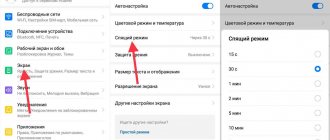Home / Phones / Android / Android Repair
Back
Published: 10/01/2021
Reading time: 8 min
This article is devoted to the problem when an Android phone or tablet does not boot into Recovery Menu mode. You will learn what needs to be done to enable this mode.
This article is suitable for phones and tablets of all Android device manufacturers: Samsung, LG, Sony, Huawei, Xiaomi, HTC, ZTE, Fly, Alcatel and others. We are not responsible for your actions.
Like any operating system, Android has a special boot mode when the gadget turns on, but the system itself does not boot. This mode is called Recovery Mode. It is available in any Android product and allows you to restore the firmware from a backup copy, change the firmware, reset the settings, or simply reboot the gadget when it freezes.
Unlike root rights, using Recovery Mode will not be dangerous, since it is not blocked by the developer. Every user can officially use this function.
- Why doesn't Android go into Recovery?
- Ways to enter Recovery Mode On the gadget itself
- Via computer
How to access the Recovery menu? Options for getting to Recovery
How to log in to Recovery? Many instructions for upgrading and flashing Android require you to perform actions from the Recovery menu. What kind of mode this is and why it is needed you will learn from this article. What is Recovery? Recovery is a special Android boot mode in which:
- Perform a full Android data reset
- flashing a smartphone
- get Root rights
How to log in to Recovery? The Recovery menu, as a rule, is found in all Samsung smartphones and tablets, but is absent in other brands of Android smartphones, but you can easily add it by flashing this section to your Android device.
If an Android smartphone has a Recovery menu and it has not been changed, then it is called STOCK, but if it did not have one or third-party Recovery menus were installed, it will be called CUSTOM.
Custom Recovery comes mainly in two types : CWM and TWRP , less common are 4ext , Philz CWM , (different development teams).
How to log into Recovery
ATTENTION! If the Recovery menu is missing or not installed, then it is IMPOSSIBLE to enter it!
Method for Samsung
Before transferring your smartphone or tablet to recovery, disconnect Samsung from the charger or USB cable!
New models
Turn off Android and hold down the Center Volume Up button + On/Off
Turn off Android and hold down the Center button + Volume Up button + On/Off button
If suddenly it doesn’t work out, use the universal method (read below).
For Samsung Galaxy S8 – S10
- Press and hold the dedicated Bixby button and Volume Up + Power
- After the splash screen appears on the screen, lower the power button, but continue to hold the Bixby button and Volume Up
- Hold these buttons until the Android logo appears on the screen with a blue background
- Release the buttons
- After a few seconds, the Galaxy S8 smartphone will boot into Recovery mode.
Older models and some tablets
- Turn off Android and hold down the Center button and the On/Off
- Turn off Android and hold down the Volume Up and the On/Off
or in a universal way (read below).
Method for HTC
Switch to bootloader mode, then:
- select Bootloader -> Recovery
- or immediately upon entering the menu there will be Recovery. In the menu, find the Recovery item and use the volume keys to get to this item and select the power button.
If suddenly it doesn’t work out, use the universal method (read below).
Method for Google Pixel and Nexus
Turn off Pixel/Nexus and hold down the Volume DOWN + ON/OFF . In the menu, use the volume keys to find the Recovery menu and confirm the selection with the ON/OFF button:
If suddenly it doesn’t work out, use the universal method (read below).
Method for SONY
Turn off, turn on and when Sony logo appears on the screen or when the indicator lights up - HOLD/Press (possible options):
- Volume DOWN
- Volume Up
- Click on the logo
- Or turn off Sony, hold down the “Power” button, wait for a couple of vibrations, release the power button and hold down the “Volume Up” button
If you can’t use the universal method (read below).
For select Motorola and Lenovo models
- Turn off Android
- Press the “Volume Up” + “Volume Down” + “Power” buttons simultaneously
For other versions of Motorola and Lenovo - turn off Android and press “Volume Down” + “Power”
If you can’t use the universal method (read below).
A universal method for all Android devices using a PC and ADB tools
(Asus, HTC, Lenovo, Sony, HTC, LG, Samsung, Motorola and others, provided that recovery is available in this device)
Adb Run Program - Method 1
Using the site's proprietary Adb Run program (don't forget to enable USB Debugging)
ADB RUN working window
From the command line - Method 2
Another option is how to get to the Recovery menu using standard ADB tools and the ADB RUN program:
Connect Android to PC and type adb reboot recovery
Example in ADB RUN:
From the command line - Method 3
As practice shows on some devices (and more specifically on LG), it is not possible to transfer an Android device using the adb reboot recovery , in this case you should use the following command
adb shell
reboot recovery
There is also a command to switch to Recovery mode for LG, you need to enter the command
adb reboot —bnr_recovery
After which the device will begin to reboot in a few seconds!
A universal method from an installed terminal with Root rights
(Asus, HTC, Lenovo, Sony, HTC, LG, Samsung and others, provided that recovery is available in this device)
- Download and install the Terminal application from the Google Play store;
- Go to the newly installed application;
- Type the following commands: su reboot recovery
- After a couple of seconds, Android will begin to reboot.
Management in the Recovery menu
Volume Up and Down —move through the menu. On/Off key —select an item in the menu. There are some Android devices that do not have a volume key ,
in this case, you will need
an OTG cable and a computer mouse.
As soon as you start putting Android into Recovery mode, connect your mouse. This concludes the article. If you don’t know how to use it and what items in Recovery are responsible for, then read the article
That's all! There is nothing complicated! Read more different articles and instructions in the section Articles and Android Hacks . Stay with the Android +1 , it will be even more interesting!
Source: https://androidp1.ru/kak-zayti-v-menyu-recovery/
Unofficial Recovery
As mentioned above, the standard Recovery Mode very often has somewhat limited capabilities, so it is best to use third-party, unofficial developments. The most popular are two of them - ClockworkMod recovery (abbreviated as CWM) and TeamWin Recovery Project (abbreviated as TWRP). Both developments have excellent functionality and allow you to very quickly and conveniently modify or change the firmware, obtain root rights, reset settings to factory settings, or restore a backup copy.
More experienced users of Xiaomi devices running Android are already aware of what Recovery and Fastboot modes are and what they are needed for. Therefore, this instruction is aimed more at beginners who want to learn a little more about the technical side of the device or who have decided to update the firmware. So, what are Recovery and Fastboot on Xiaomi, how to turn them on and off
?
Android phone does not boot beyond the logo/splash screen (turns on but not completely) - what to do
Now let’s figure out why your Android phone doesn’t load beyond the logo (it doesn’t turn on after the manufacturer’s or robot’s splash screen). Further in the text: first about the reasons and then a deciphering of what to do in this or that case.
This article is suitable for all brands that produce phones on Android 10/9/8/7: Samsung, HTC, Lenovo, LG, Sony, ZTE, Huawei, Meizu, Fly, Alcatel, Xiaomi, Nokia and others. We are not responsible for your actions.
Recovery Mode
Recovery mode, or recovery mode, is a special menu that allows you to perform certain actions with your smartphone. There are two types of them: stock and custom.
Stock Recovery
Installed with official, factory firmware. It is quite meager in its capabilities. Usually there are only 3 functions: (clearing the Data partition) and connecting to the Mi assistant
(Connect with MIAssistant).
Custom Recovery or TWRP
This is Recovey from third party developers. It is installed by you yourself, instead of the stock one (sometimes, sellers install non-official firmware, for example from MIUI Pro, and therefore, most likely, you already have a custom Recovery).
It looks completely different. Usually, when loading into it, a language selection menu first appears, which includes English. Actually, you need to choose it, unless, of course, you speak Chinese. The selection might look like this:
Or like this (here we can perform several tests, and also immediately get into recovery
or
fastboot
):
Here are the wipes of various sections ( Wipe
), and the ability to create a backup (
Backup
) of any information on your smartphone (including IMEI), and most importantly, what it is used for most often is firmware (
Install
). And in general, there are still a lot of interesting things. We will not go into detail, because... This is a very broad topic. Perhaps we will make a separate instruction on it.
How to log into Recovery?
This is done very simply:
- Turn off the smartphone
- Press and hold the volume up and power buttons. Hold it until the download starts.
Navigation through this menu is done using the volume keys. Confirm your choice with the power button. Custom Recovery also supports touches.
How to exit Recovery?
- Find the item Reboot
, select it and confirm with the power button. - If for some reason the first step did not work, then simply hold the power button for a long time.
Reset to factory settings (hard reset) on Samsung Galaxy
Step-by-step instructions on how to perform a hard reset on Samsung Galaxy mobile phones and tablets: J3, J5, J6, J7, S8, A5, DUOS, Galaxy Tab.
:
Resetting data, or hard reset – deleting recorded data from the phone. All messages, contact phone numbers, photos, music, audio, mail settings are deleted. In this case, the tablet/phone “rolls back” to its factory (that is, original) state.
Resetting settings helps when problems arise that cannot be resolved by other means, for example:
- if applications are not installed,
- the device is not working correctly,
- There are errors in the operation of Android after the firmware.
It makes sense to do a hard reset before selling or transferring to another user. This way you are guaranteed to delete all confidential data.
Before you factory reset your Samsung Galaxy, make a backup of all your important data because it will be erased.
Be sure to delete your Google user profile - otherwise, after a hard reset, the device will ask for a login password. If you (or the new owner) fail to enter them, Android will not be able to boot. How to do this, read the link:
Deleting a Google Profile
As a last resort, you can unlock the device in, but you need to have documents with you that confirm that you are its buyer.
Step-by-step Hard Reset on Samsung Galaxy phones
There are several ways to reset your Samsung.
Factory reset via menu
1. Open the Android menu, and select “Settings” - “General”.
2. You need the option “Backup”, “Reset” or “Privacy” - the names are different, depending on the version of Android.
3. In the “Data Reset” section, click the “Reset” button to perform a Hard Reset.
4. The tablet/phone will reboot automatically.
That's it, the settings have been reset, the data has been deleted.
Resetting settings via phone hardware keys
This “zeroing” method will help if
- Android OS won't start
- Samsung device screen is locked,
- no access to settings.
So, in order to reset the settings without loading the Android OS,
- Turn on your mobile device by pressing the hardware button Power . It is usually located on the side or top.
- Press the Power , Home and Volume Up . If there is no Home button, just hold down the other two buttons. If there is a Bixby , you must press it too.
- Release the Power as soon as Samsung Galaxy appears on the device screen
- Recovery appears .
- If there is no Recovery sign, repeat the previous steps, holding the buttons for a longer time.
- Use the Volume Down to navigate the menu. Find Factory Reset .
- Click on the Factory Reset option by pressing the Power button.
- Use the Volume Down key to confirm deletion ( Yes ).
- Press Power to reboot your device.
After these steps, the data on Samsung will be reset.
Locking your phone after a Hard Reset: what to do
Starting from Android 5.1, anti-theft protection – Google FRP – is activated on Samsung mobile devices. It works as follows: – when you perform a data reset without first deleting your Google account, the device is blocked.
Let's say you restored your phone to factory settings, forgot to delete your account data - and when you turn it on, the phone asks you to enter the login data that was entered before the reset. In this case, there are two solutions:
- Enter the correct username/password to log into your account
- Contact the service with documents confirming that you purchased the device.
If you do not have a coupon, receipt, or agreement, you will be denied unlocking. Therefore, be careful and strictly follow the instructions when performing a hard reset.
No Russian language after factory reset
I deleted the account on the Samsung Galaxy A5 and the phone was reset to factory settings. After this, languages disappeared, including Russian and Ukrainian. How can I get them back? You can set Russian in the browser, but there is no such thing in the settings of the phone itself, only English and a few more.
What can you do in recovery mode?
- Install official, custom firmware, any archives with programs, for example, GAPS, programs for obtaining ROOT rights and much more.
- Perform a factory reset, delete the cache, clearing the memory of unnecessary “junk” and garbage.
- Back up data and then restore it.
- Mount and format specific partitions of the file system.
When entering Recovery for the first time, most people have questions regarding the items that appear and what they mean, because they are all in English and without explanation, so we will translate the main ones and explain what they do:
- wipe cache partition
Reset the application cache partition, it can help if the device becomes slow or applications do not work correctly - wipe data factory reset
Reset the data of all applications, in other words, do a Hard Reset (more details) - reboot to system
Reboot and go to normal mode, essentially exiting recovery
How to enter the Recovery menu on Android
In this article we will talk about what Recovery Mode is on Android, how to enter it on various models from popular manufacturers, and also answer some frequently asked questions.
What is Recovery?
Recovery mode is the so-called “recovery mode” of the Android system. Factory Recovery, which comes on the device out of the box, has limited functionality, but even from it you can perform a complete system reset or install official firmware.
With a modified Recovery (CWM or TWRP), a number of new functions appear, including the ability to obtain root rights, install custom firmware and kernels, create system backups and restore from backups, as well as other interesting options, which we will discuss in a separate article.
How to log into Recovery: instructions
To get into Recovery on Android devices, you first need to turn off the device, and then press and hold a certain key combination until the screen lights up. Unfortunately, there is no single combination with which you can enter the Recovery menu on both Samsung smartphones and HTC, LG, Xiaomi, etc. Therefore, below we have collected instructions for various models.
(!) True, there are three almost universal methods - more details about each are written at the end of the article:
- Once you connect your Android device to your computer, you can put it into recovery mode through the Windows command line using ADB.
- Special applications allow you to enter the Recovery menu from the system.
- Via the Terminal by entering the command (ROOT rights are required).
(!) There you will also find information on what to do when a recumbent Android appears on the screen with an exclamation mark in its belly and the inscription “No command.”
(!) Also, some smartphones and tablets do not have Recovery. In this case, you will have to install it yourself (if, of course, a custom recovery is developed for this model) - links to instructions are above.
Navigation through the menu is carried out using the volume up and down keys, and selection is made with the power/lock button. On new devices, CWM and stock recovery can be touch-sensitive.
Lenovo
With your Lenovo smartphone turned off, press and hold at the same time:
If it doesn't work, use:
- Volume “+”, Volume “–” together with the power button
Nexus, Pixel
If you have a Google Nexus or Pixel tablet or smartphone, you will first have to go into Fastboot mode, and from there go to recovery. To do this, hold:
- Volume Down + Power On
Then use the volume keys to switch the arrow to “Recovery mode” and select this item by pressing the power/lock button.
HTC
Use a combination:
On some (you will go straight to Recovery):
On most HTC devices you will first be taken to Bootloader. Then, using the volume keys, go down to the “Recovery” item and go to it by pressing the power button.
In the Bootloader menu itself there is a “Factory reset” item, which is responsible for resetting the phone to factory settings.
Samsung
In modern Samsung models, the following key combination is used to enter recovery mode:
- Home button + volume up + power on
On older devices:
On older Samsung tablets:
- Volume up + power on
Meizu
Meizu smartphones do not have the usual non-touch recovery, but there is a menu from which you can install the firmware or reset the settings to factory settings.
To get into it, use the following combination:
LG
- Hold down the Volume Down and Power keys until the LG logo appears.
- Then quickly release them and hold them again.
- Wait for the menu to load.
Xiaomi
With your Xiaomi phone turned off, hold these keys:
- Volume “Plus” + power on
The Xiaomi recovery menu is available in several languages (works in Chinese by default). To change to English, click the button as shown in the photo.
After this, you can boot Xiaomi into Fastboot, Download or Recovery modes.
Sony
Many Sony phones do not have stock Recovery installed (you will have to install TWRP - there is a link to the FAQ at the beginning of the article) and only some models have it. You can log in using one of the combinations (try one at a time):
- “ON” + Volume “Minus”
- “ON” + short press Volume “Up” until the SONY logo appears, then quickly press Volume “Plus” again
- “ON” + volume down + volume up
Huawei, Honor
For phones and tablets from the Chinese manufacturer Huawei or Honor:
- Volume "Down" + Power
- Volume "UP" + Power
Motorola
- Press and hold the Power and Volume Down keys for 2-3 seconds, then release them.
- You will be taken to Fastboot Flash Mode. Using Volume “Down”/“UP” change the option to “Recovery Mode”.
- Confirm your selection with the power button.
Fly
Hold until the “Fly” logo or vibration appears, one of these combinations - depends on the specific model:
- Volume “Down” + turn on
- Volume “UP” + turn on
Asus
- Hold down the Power key and Volume “+” (second option: Power and Volume “–”).
- After vibration, release the power button, continuing to hold Volume down until Recovery appears.
Chinese phones with MTK processors: Doogee, Bluboo, Blackview, Oukitel, Elephone, UMI and others
- Hold Volume "UP" + "ON".
- When the menu appears, move to the “Recovery” item using the Volume “UP” button, confirm with Volume “Down”.
We put the device into recovery mode via a computer: a universal method
Download and install ADB and drivers, connect your Android device to your computer via USB, activate debugging. Launch ADB and enter in the command line:
adb reboot recovery
Press “Enter”, after which the device will reboot into Recovery mode.
Using a useful application
There are special programs that can put your device into Recovery Mode in one click. For example, Boot Droid. Simply select “RECOVERY” from the list of options and confirm your choice by pressing “YES”.
Entering Recovery Mode via Terminal Emulator
Download Android Terminal and type the following command:
su
Press “Enter”, a request for root access will appear, grant it.
Then enter:
reboot recovery
Click “Enter” again and the phone will instantly reboot into Recovery Mode.
Problem performing a hard reset, message "No command"
While trying to follow the previous process, we might have encountered a problem that may cause us a lot of doubts and which becomes a stone in the way of fixing a mobile phone that won't turn on . However, the solution is simpler than we think, when the "No command" message appears, we just need to do the following:
- All we need to do at this point is to hold down the Power button for two seconds.
- Then we give it just one touch to increase the volume.
- Instantly, the mobile phone will be forced into recovery mode and we can continue with the steps we showed you earlier.
A universal method for all Android devices using a PC and ADB tools
(Asus, HTC, Lenovo, Sony, HTC, LG, Samsung, Motorola and others, provided that recovery is available in this device)
Adb Run Program - Method 1
Using the site's proprietary Adb Run program (don't forget to enable USB Debugging)
ADB RUN working window
From the command line - Method 2
Another option is how to get to the Recovery menu using standard ADB tools and the ADB RUN program:
Connect Android to PC and type adb reboot recovery
Example in ADB RUN:
From the command line - Method 3
As practice shows on some devices (and more specifically on LG), it is not possible to transfer an Android device using the adb reboot recovery , in this case you should use the following command
adb shell
reboot recovery
There is also a command to switch to Recovery mode for LG, you need to enter the command
adb reboot —bnr_recovery
After which the device will begin to reboot in a few seconds!











